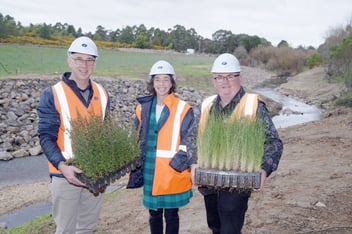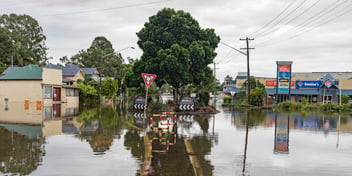Will we be swimming in Sydney's Parramatta River by 2025?
A worldwide trend to reclaim urban waterways could see Australia’s own Parramatta River ready for swimming by 2025, writes Thea Cowie.
London’s Thames River was declared partially “biologically dead” by the Natural History Museum in 1957. Boston’s Charles River, known as ‘The Dirty River’, was notorious for turning up more than its fair share of dead bodies. Waterways in Paris, Zurich, Berlin, Copenhagen and New York had similarly chequered histories as “open sewers” and “industrial waste dumps”.
Yet each is being cleaned up, opened to recreation and – in some instances – declared swimmable. Australia’s own Parramatta River is part of this global trend to reclaim urban and suburban waterways. The Parramatta River Catchment Group’s (PRCG’s) ‘Our Living River campaign’ aims to make the waterway swimmable by 2025.
And it’s a target that’s within reach, if overseas success stories such as Boston’s were anything to go by, said University of New South Wales Water Expert Dr Stuart Khan.
“It shows us you really can generate community support for transforming a polluted urban river into something that people can enjoy – Boston’s a lot colder than Sydney and doesn’t have nearly as many nice swimming days,” Khan said.
“Boston also shows us it’s technically possible – there are major challenges but it’s a question of how willing are you to do it?”
A short history
The Parramatta River runs some 222 km from Blacktown Creek to Lane Cove River. It’s fresh water up to the Charles St Weir in Parramatta, after which it becomes estuarine and gradually saltier closer to the ocean.
The catchment takes in 257 square kilometres and is home to almost 1 million people.
Traditional landowners and European settlers regularly swam in the river until the 1960s when bathing facilities were closed due to water quality issues associated with run-off, effluent and industrial pollution.
Sydney Water’s Service Planning Lead, Phillip Birtles, said: “It’s well known that the past history of the river included some very toxic chemicals that are still in the river sediments.”
Tide of change
Efforts to improve water quality began in earnest in 2008 when the PRCG was established, bringing together community groups, local councils and state government agencies. By 2015, all 11 councils within the catchment area had joined the PRCG, along with the Environment Protection Authority, the Department of Planning and Environment, and Sydney Water.
Birtles said residents and developers were placing increasing value on the social and health benefits of high-quality open spaces.
Currently, however, there are just four safe sites for swimming in the Parramatta River: Cabarita Beach, Dawn Fraser Pool, Chiswick Baths and Lake Parramatta.
“As development has moved west and Parramatta has been identified as the second CBD, the desire for landscape features and recreation space has become more important and more urgent,” Birtles said.
Calculated moves
In a bid to expand the number of safe swimming sites, numerous water quality improvement measures have been deployed by the PRCG’s members, said the group’s Chair, Councillor Mark Drury.
“Measures include installation and maintenance of stormwater harvesting and re-use systems, gross pollutant traps, bio-filtration systems along roads and constructed wetlands,” he said.
Sydney Water owns and operates 13 of these traps along the Parramatta River and in 2016-17 these traps collected 168 cubic metres of litter and 85 tonnes of sediment.
Another powerful tool has been the Get the Site Right campaign – a crackdown on erosion and run-off from building sites that has seen councils and the EPA issue penalties of between $8000 to $15,000 per incident since 2016.
Overcoming challenges
Today, the key sources of pollution in the Parramatta River come from wet weather overflows from the sewer system and stormwater.
“Stormwater carries bacterial contamination – for example, from dog faeces and wet weather overflows – and chemical contaminants from industry and business, roads, and other hard surfaces,” Drury said.
Khan added that the key to reducing the inflow of these pollutants was Water Sensitive Urban Design (WSUD).
“The only way we’re going to keep a river clean is if we can ensure that rain arrives clean at the river,” he said.
“We need state government-led strategy to implement WSUD in the way we design our cities as a whole, rather than just a hodgepodge of random developments.”
Environmental chemist and adjunct professor at the University of Sydney, Gavin Birch, has been studying the Parramatta River for 25 years.
He said the second major issue with water quality in the catchment was “the possibility of legacy contaminants, such as dioxins from Homebush Bay, and chrome from the upper part of the estuary”.
Birch suggested wider usage of stormwater infiltration basins could help deal with this legacy, as well as overflows and issues associated with high-turbidity.
“Sediments remain a problem – the water is very dynamic and changes very rapidly spatially and temporally,” he said.
“SIBs [Stormwater Infiltration Basins] would take water from canals entering the Parramatta River and capture quite a significant part of the contaminants, including nutrients, at a reasonable cost.”
Future plans
While Parramatta River has been the subject of numerous water quality monitoring projects over the years,
there has never been a catchment-wide, holistic monitoring program.
Khan has been building a business case for such a program, which could also aid the creation of national recreational water quality guidelines that are appropriate for rivers.
“We have guidelines that work very well at beaches and in unpolluted environments, but are they equally appropriate for rivers? I’d suggest the answer is no,” he said.
Then there is also the issue of accommodating 11 different local government areas, plus state authorities and the wider public.
The PRCG’s recommendations on governance were unveiled in the Parramatta River Masterplan, which launched in October last year, Drury said.
“It [outlines] a sustainable governance structure... including a lead coordinating agency and accountabilities for each state and local government agency.”
Moving beyond the current
One common barrier to change isn’t an issue here as there’s positive, meaningful and sustained community and stakeholder engagement in abundance.
In the summer of 2014-15, when Lake Parramatta opened to swimming for the first time in 72 years, more than 12,000 people leapt at the chance.
By 2016-17, the swimming site attracted more than 40,000 visitors.
Recent PRCG survey results show 68% of residents who swim are interested in taking a dip in designated areas along the river.
It’s this kind of community support that makes Drury believe that: “Sydney could become a leading global river city, with a world class Parramatta River that feeds our world-class Sydney Harbour”.
First published as 'Swimming with the tide' in Current magazine May 2018.


